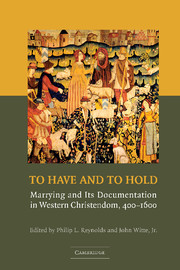Book contents
- Frontmatter
- Contents
- List of Contributors
- Preface and Acknowledgments
- List of Abbreviations
- 1 Marrying and Its Documentation in Pre-Modern Europe: Consent, Celebration, and Property
- 2 Marrying and Its Documentation in Later Roman Law
- 3 Marrying and the Tabulae Nuptiales in Roman North Africa from Tertullian to Augustine
- 4 Dotal Charters in the Frankish Tradition
- 5 Marriage and Diplomatics: Five Dower Charters from the Regions of Laon and Soissons, 1163–1181
- 6 Marriage Agreements from Twelfth-Century Southern France
- 7 Marriage Contracts in Medieval England
- 8 Marriage Contracts and the Church Courts of Fourteenth-Century England
- 9 Marrying and Marriage Litigation in Medieval Ireland
- 10 Marriage Contracts in Medieval Iceland
- 11 Contracting Marriage in Renaissance Florence
- 12 Marital Property Law as Socio-Cultural Text: The Case of Late-Medieval Douai
- 13 Marriage Contracts, Liturgies, and Properties in Reformation Geneva
- Index
11 - Contracting Marriage in Renaissance Florence
Published online by Cambridge University Press: 12 September 2009
- Frontmatter
- Contents
- List of Contributors
- Preface and Acknowledgments
- List of Abbreviations
- 1 Marrying and Its Documentation in Pre-Modern Europe: Consent, Celebration, and Property
- 2 Marrying and Its Documentation in Later Roman Law
- 3 Marrying and the Tabulae Nuptiales in Roman North Africa from Tertullian to Augustine
- 4 Dotal Charters in the Frankish Tradition
- 5 Marriage and Diplomatics: Five Dower Charters from the Regions of Laon and Soissons, 1163–1181
- 6 Marriage Agreements from Twelfth-Century Southern France
- 7 Marriage Contracts in Medieval England
- 8 Marriage Contracts and the Church Courts of Fourteenth-Century England
- 9 Marrying and Marriage Litigation in Medieval Ireland
- 10 Marriage Contracts in Medieval Iceland
- 11 Contracting Marriage in Renaissance Florence
- 12 Marital Property Law as Socio-Cultural Text: The Case of Late-Medieval Douai
- 13 Marriage Contracts, Liturgies, and Properties in Reformation Geneva
- Index
Summary
In May 1453, a clandestine wedding occurred in Florence. Two years later, it gave birth to a notorious lawsuit. The groom, Giovanni di ser Lodovico della Casa, denied that the ceremony had ever happened and that his relationship with Lusanna di Benedetto, widow of Andrea Nucci, was nothing more than sexual. The entire legal proceeding was ecclesiastical. The only secular complication was a suit to see if the podestà had jurisdiction, and that was settled early and without input from the parties. (If dowry had been at issue, the case would have come before a secular court.) The subsequent judgment in favor of Lusanna made by the court of Archbishop Antonino, the sainted moral and legal reformer, shows that he placed credence in the fact of the wedding ceremony as well as in certain other bits of evidence (although the judgment was reversed on appeal to Rome). That ceremony presents us, therefore, with an interesting and illuminating point of entry into Florentine marital customs and their relation to canon law. We can come to appreciate what made this wedding secret, in contrast to those that were public knowledge; or, pressing a bit further, what would have rendered their relationship a marriage rather than concubinage, which was the most that Giovanni della Casa would admit.
The ceremony took place in Lusanna's brother's house and involved a small contingent of witnesses, even including a friar and a young novice summoned from Santa Croce, but not including any kin of the groom.
- Type
- Chapter
- Information
- To Have and to HoldMarrying and its Documentation in Western Christendom, 400–1600, pp. 390 - 420Publisher: Cambridge University PressPrint publication year: 2007



